News:
On Provenance, Prints and People - A Stroll Through the LBI London’s Secret Art Gallery
Kinga S. Bloch
Did you know that libraries can also serve as the custodians of secret art galleries?
In our 12th Snapshot of German-Jewish History and Culture, we would like to introduce our readers to a unique set of etchings and woodprints that is tucked away beneath the covers of the books in our library: a hitherto dormant collection of ornate late 19th and early 20th century imagery that tells us stories about both the practice of collecting books and the self-perception of German-Jewish book collectors. To be more specific, we want to take you for a stroll through our small but nonetheless compelling gallery of Jewish ex libris and talk a little bit about the people who owned them.
Ex libris (Latin: ‘from the books [of]’) is another term for a bookplate that is glued or stamped on the inside cover of a book to signify ownership. The practice of attaching these often intricately designed miniatures originated in the 15th century when Johannes Gutenberg (aka Johannes Gensfleisch, c. 1400-1468) developed a printing press with movable type in Mainz. In the wake of his revolutionary invention that allowed for printing many copies of the same texts with ease, the number of books produced increased significantly. As book ownership rose, so did the desire to mark one’s collection with a personal expression to signify ownership. Bookplates were commissioned with famous artists such as the German painter Albrecht Dürer (1471-1528), who designed and made woodcuts for several proud bibliophiles. The first bookplate known to have belonged to a Jew, however, dates from the 18th century.
Early bookplates predominantly bore the owner’s coat of arms and often remained in use for family collections over generations. This practice was common amongst a small elite; however, the use of ex libris was more widespread in the 19th century, when they became popular amongst the rising middle classes in Europe. In this period, the focus in the art of ex libris moved from the expression of lineage towards a more personal angle. The latter celebrated the book owner’s individuality by means of visual references to personal interests, intimate connections, professional achievements, and so forth. It is also in this century that the visual language of the ex libris diversified in relation to the tastes of the time. Contemporary developments and fashions in aesthetic tastes translated into visual references to classical antiquity, oriental art, religion, and esoteric imagery, to name just a few. It is in this wider historical context that we must approach the specific aesthetics of Jewish bookplates from the 19th and early 20th century. European-Jewish bookplates from this period can be divided into several categories that are beautifully described in Philip Goodman’s seminal collection of Illustrated Essays on Jewish Bookplates.
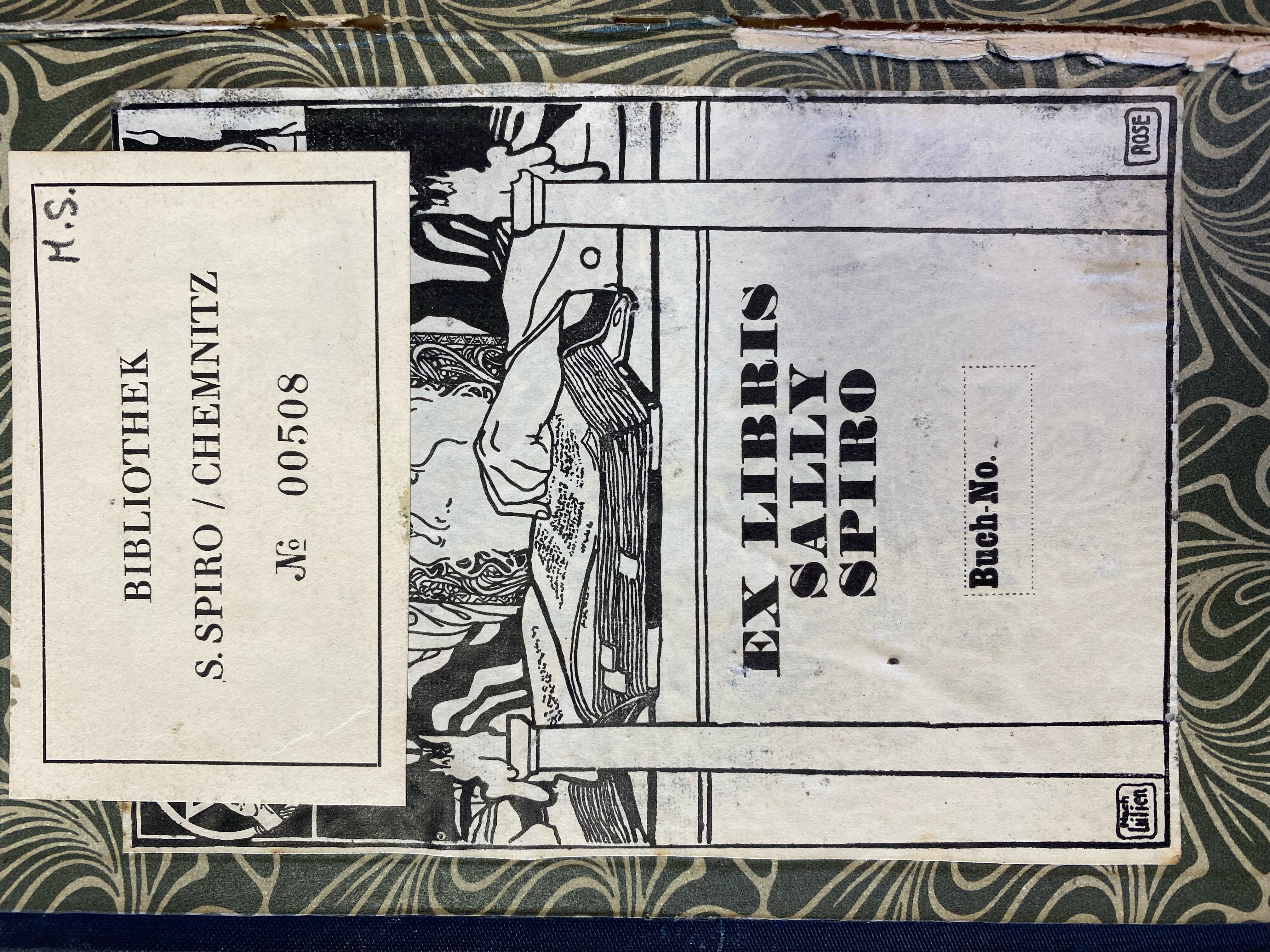
Ex libris Sally Spiro
Our library merely holds one set of ex libris inspired by leading Jewish artists in the field such as Sally Spiro's bookplate dwelling on the art of E.M. Lilien (1874-1925) that can be found in large numbers, for example, at the Hebrew Union College in Cincinnati. Nonetheless, the LBI London library features a unique collection of ex libris that represent typical stylistic elements of this artform.
To begin with a popular form of reference, there are examples of ex libris that visualise the love of books by portraying the owner surrounded by his library (e.g. Harold Aufochs' ex libris). In some instances, there are clear references to the owner’s profession, like in the case of Adolf Heilborn, a German doctor and author who is depicted writing at his desk. In this image, a dynamic impression of the Rod of Asclepius is placed next to him. Another pattern symbolising a love of learning, or to be more precise, the value attributed to the study of Jewish Law can also be found in a wide range of Jewish bookplates. References equating “Torah” with “light” are common and Hebrew letters are often used in ex libris that quote from scripture.
In some cases, the visual language in the bookplate is complex and not easy to unravel. One such example is Rudolf Bleistein’s bookplate displaying the quote ‘Mehr Licht’ (More Light) alongside a male figure in what was then considered ‘oriental’ attire and a nude female figure kneeling beside him. It might be a reference to the mythical last words that one of the most revered German authors, Johann Wolfgang von Goethe (1749-1832), allegedly uttered on his deathbed; however, without further research into Rudolf Bleistein's biography, we cannot be sure. Several of the bookplates in the LBI’s collection express a love of Zion by means of visual reference to the landscape of Israel (e.g. Hermann Berlak's bookplate).

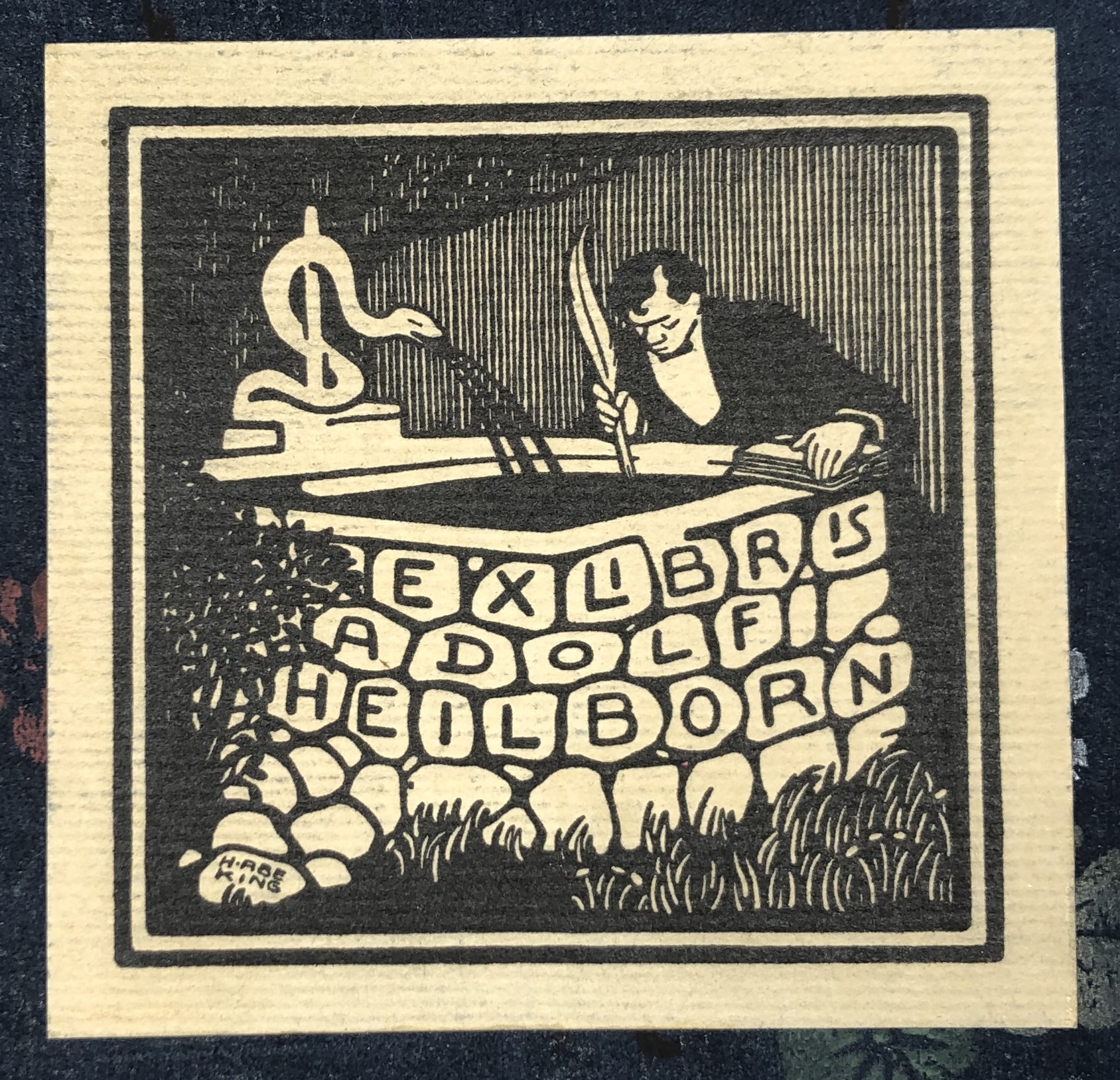
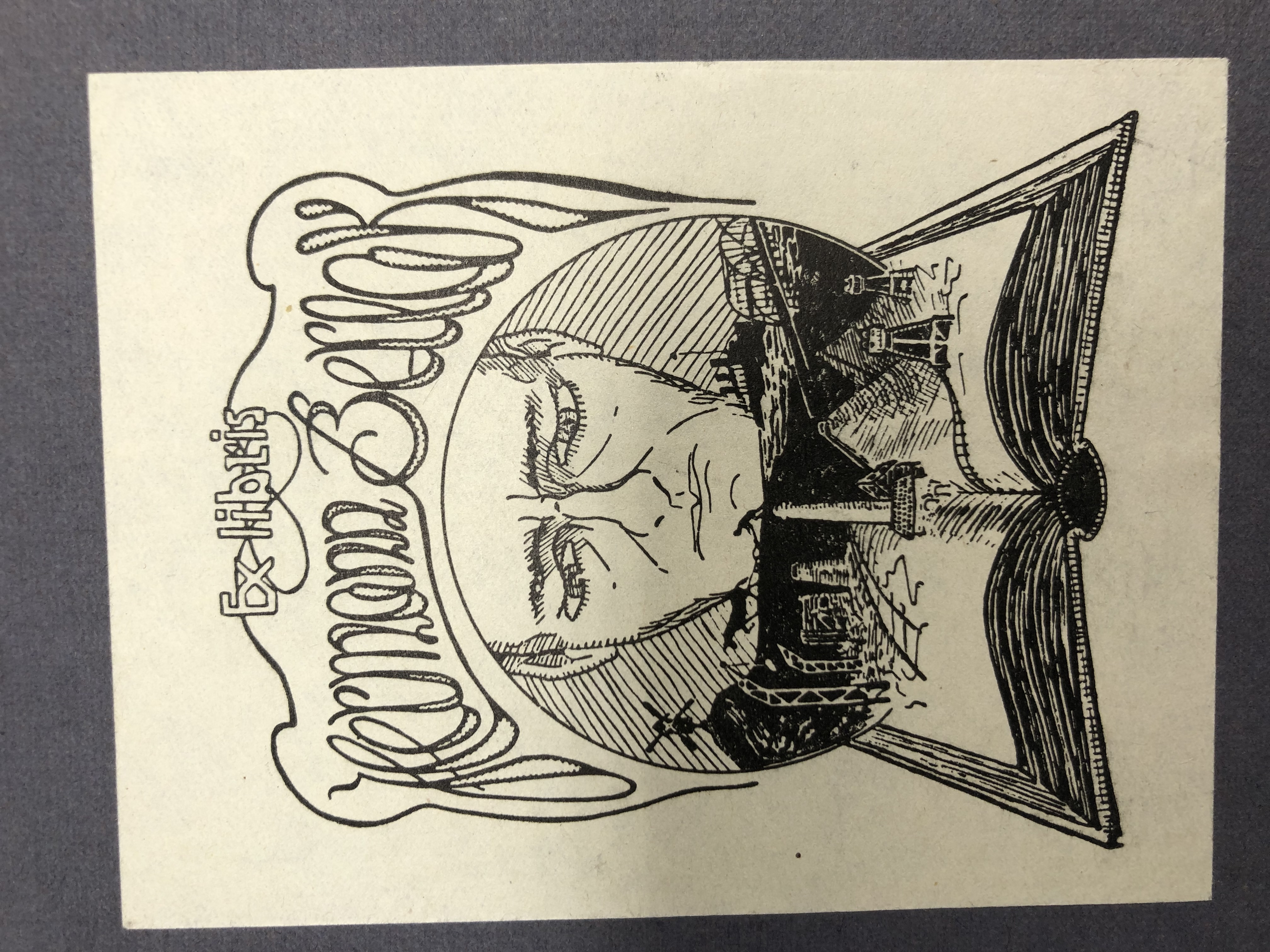
Goodman also mentions that visual references to music are common, however, we could not find items that would fit this description in our collection. Instead, we have come across some intricately designed images of beautiful female figures and faces. Two examples of such visually striking objects are an Art Nouveau drawing of an attentive girl with a flowery headdress that adorns Willy Cohn’s ex libris and a lady of unearthly beauty in a floating dress, who is fixing the spectator with her dreamy gaze. The latter belonged to a bibliophile by the name of Lewandowsky. At times the meaning behind these mesmerising images escapes precise insights into their owner’s self-perception and would require further academic investigation into their biographies.It is nonetheless evident that these little works of art are far more than visually stimulating treats concealed beneath the cover of a book and awaiting pleasantly surprised discovery. Ex libris inform the enchanted visitor happening unexpectedly upon this unusual art gallery about aesthetic tastes, professional profiles, spiritual beliefs, the love of reading, and about anything that the creator and commissioner of the bookplate considered important to them.
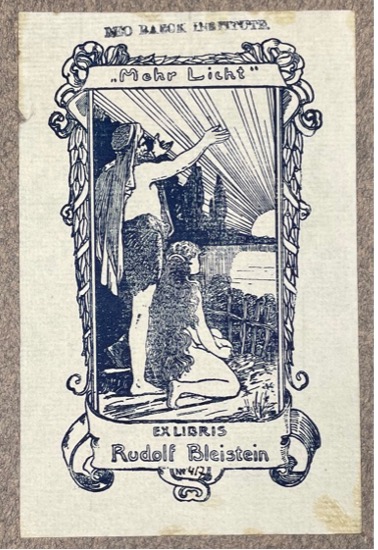
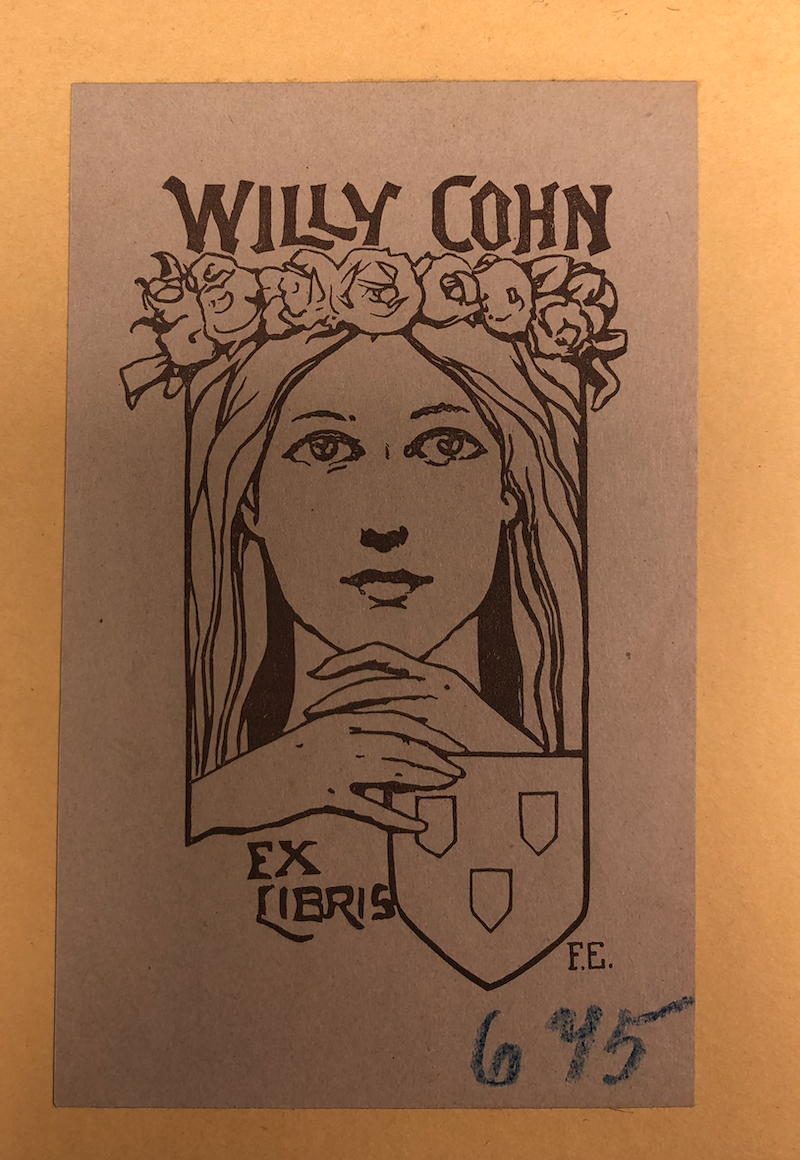
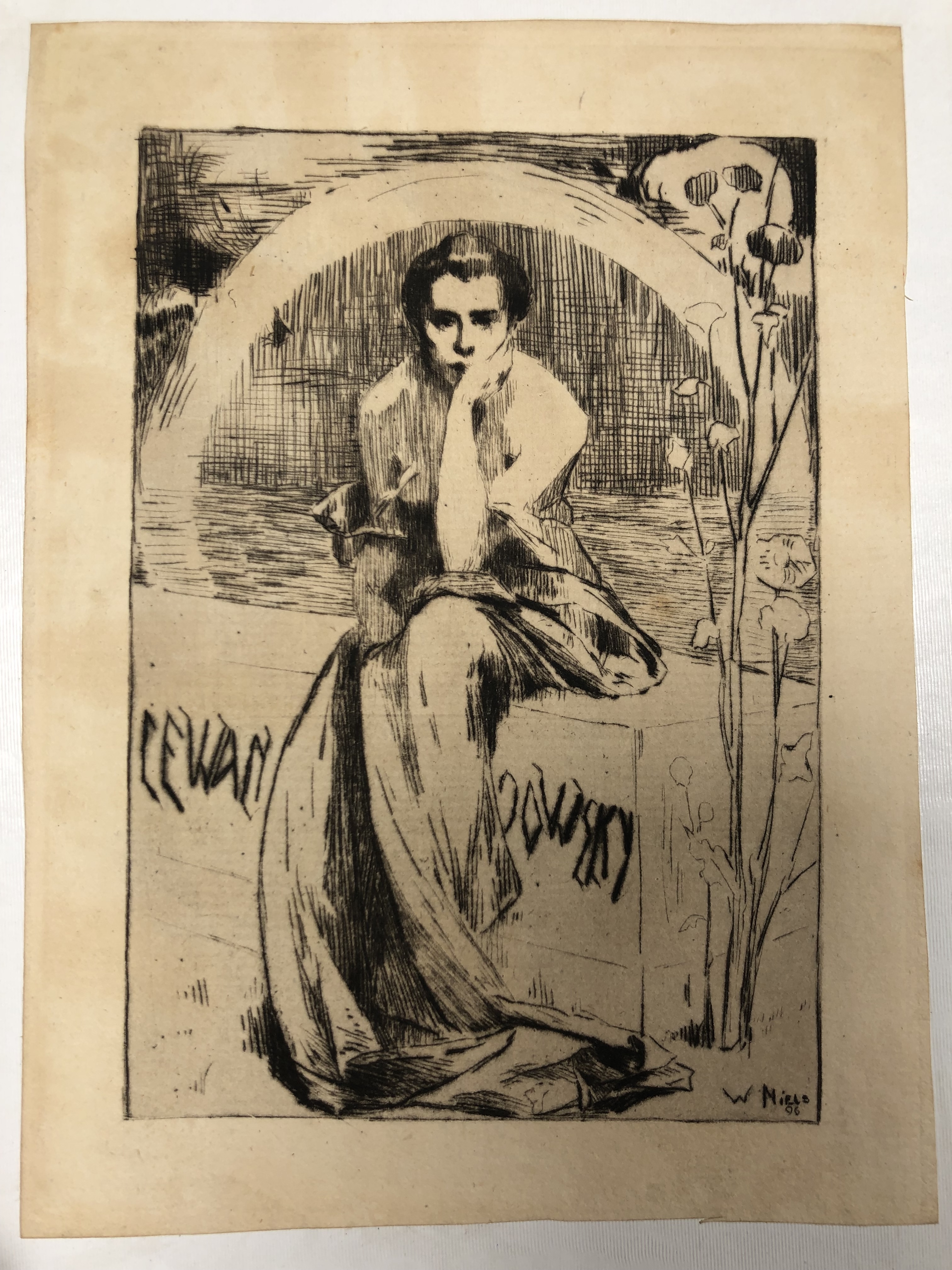
The ex libris at the LBI London, however, must also be seen as testimonies to the fabric of the community of German-Jewish refugees in Britain. They are multi-layered and complex sources that quite literally illustrate the paths of German-Jewish libraries, or more precisely, individual books in the aftermath of the Holocaust. They thus can be read as physical traces of the journeys that brought German-Jews to Britain.
Whilst we are only at the beginning of understanding and mapping the connections to the community of German-Jewish refugees in Britain that are reflected in our library, we do have a few insights into some biographies of individuals and families whose books have made it onto our institute's shelves. Let us introduce you to three case studies about German-Jewish refugees whose books and ex libris are now at the Leo Baeck Institute London.

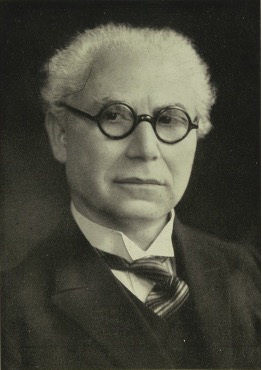
Ex libris Lazarus Goldschmidt Lazarus Goldschmidt
Our first example is the ex libris of the famous orientalist Lazarus Goldschmidt (1871, Plungen, Lithuania – 1950, London) who was a keen collector of rare books. He is best known for his translation of the entire Babylonian Talmud which took him 25 years to complete. Goldschmidt also translated the Qur’an into Hebrew and published widely on Ethiopian literature. After his rabbinical education in Slobodniki, near Kovno, he studied ‘Orientalism’ (Orientalistik) and literature – with a focus on Ethiopia – in Berlin and Straßbourg. Goldschmidt designed this bookplate himself: it displays fruit trees and a farm worker planting new saplings.
According to Philip Goodman, each tree represents a work translated or written by Goldschmidt. This bookplate celebrates the production of books – the author visualises his oeuvre in a symbolic manner here. Our research has also lead us to the interesting discovery that the bookplate was so dear to him, that it inspired the design of his tombstone to commemorate his intellectual achievements.
The provenance of the only title at the LBI holding this bookplate (Dr. Strousberg und sein Wirken: von ihm selbst geschildert, 1876) would be a very interesting case for a provenance researcher, as it is commonly assumed that Goldschmidt’s famous and valuable book collection was purchased in its entirety by the Royal Library of Copenhagen in Denmark. It can still be accessed there to this day under the name Goldschmidt Collection. The scholar Lazarus Goldschmidt had to sell his books before his forced emigration from Nazi Germany to London in 1933. He lived in Britain until his death in 1950.

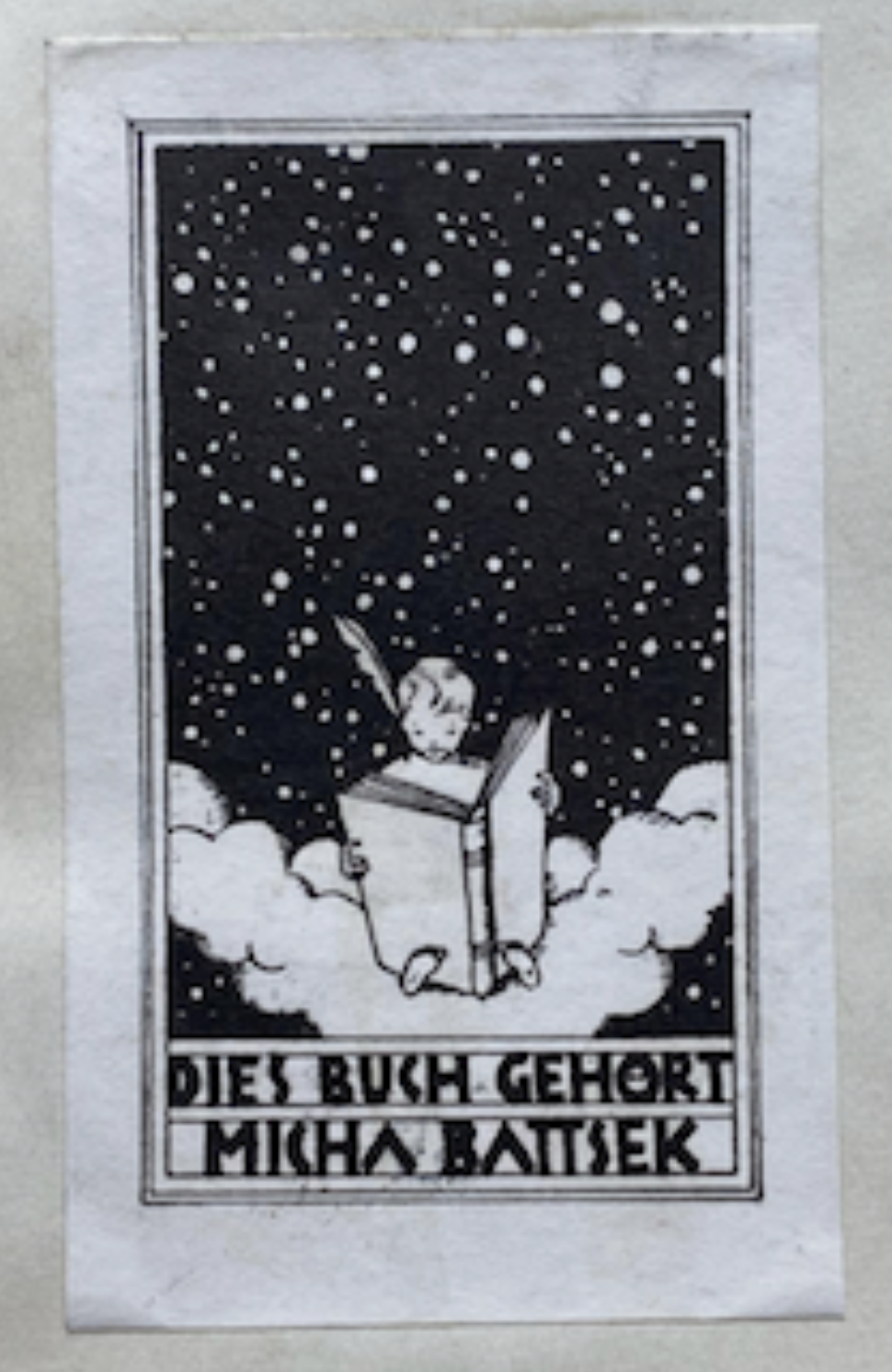
Ex libris Kurt and Rose Battsek. Ex libris Micha Battsek
This bold floral ex librisbelonged to Kurt (1886 – 1978, London) and Rose Battsek. The rose displayed in this wood- or linoleum-cut represents a common element often found in bookplates: it is a visual reference to Rose’s name. We have been able to research some information about the owners of this item. The AJR(Association of Jewish Refugees) Information Gazette of December 1978 published with a very moving, personal obituary about Kurt Battsek, who is described as a kind and cultured man. The text informs us that he left Germany shortly after Hitler came to power in June 1933, arriving in London, where he joined Otto Schiff at Woburn House, the base of the Jewish Refugees Committee between 1933 and 1939. His task was to assist newly arrived refugees to establish themselves. Unsurprisingly, the obituary emphasises that he was widely read and that he ‘truly represented the section of German Jewry which produced a creative synthesis between German culture and consciousness of Jewish religion and history.’ This assessment is borne out across the selection of 26 books that could be attributed to the Battseks via their ex libris at the LBI’s library in works published before 1950: they all engage with various aspects of Jewish history and culture.
The family’s interest is also tangible in another ex libris – Kurt and Rose’s son Micha Battsek owned a popular German-Jewish Almanac for German children, the Jüdischer Jugendkalender (1934). His copy, signed by the author Emil Bernhard Cohn with a personal dedication to the child, is adorned with a beautiful ex libris showing a little boy reading a large book, whilst sitting on a cloud against the backdrop of a starry night sky.
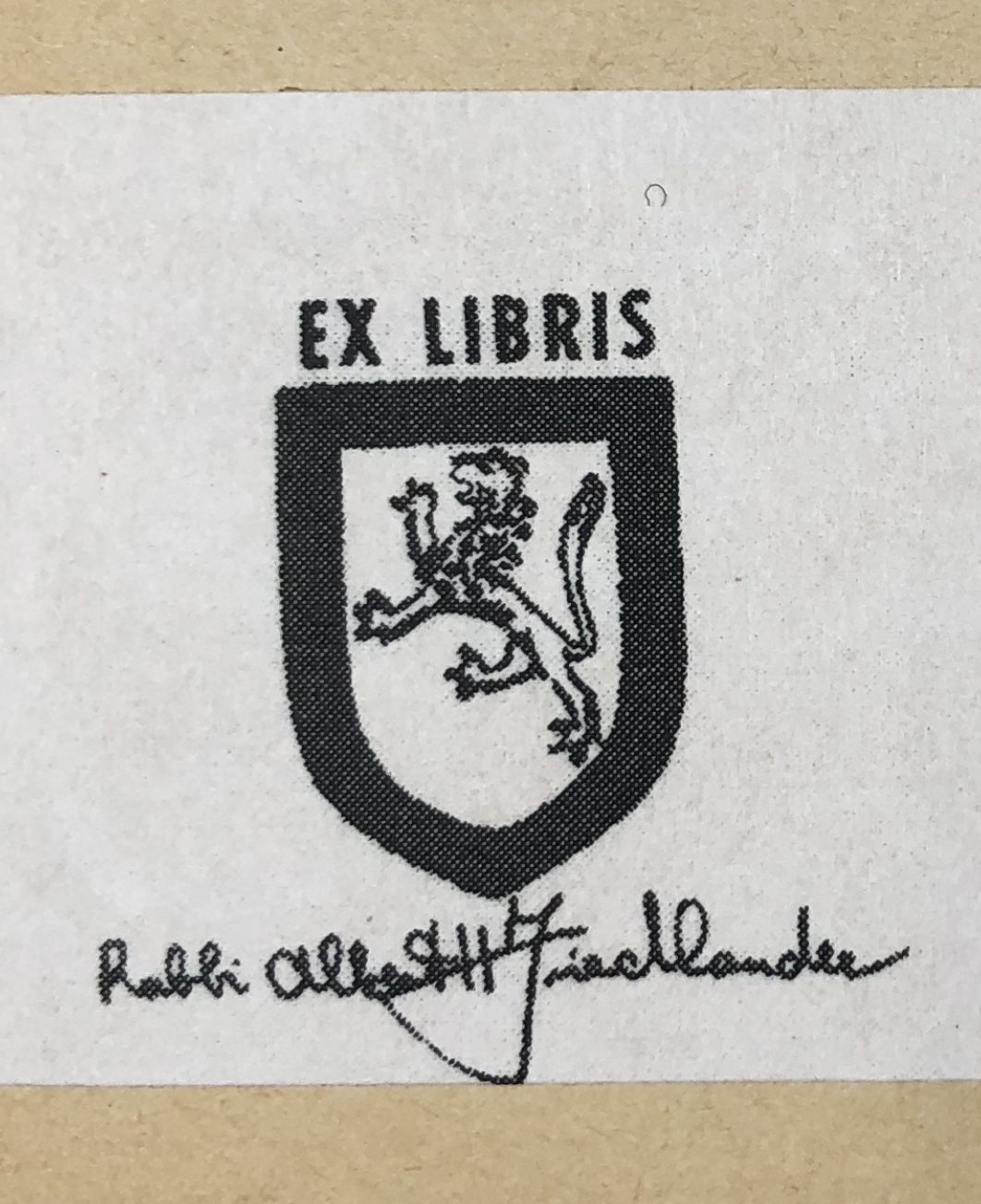
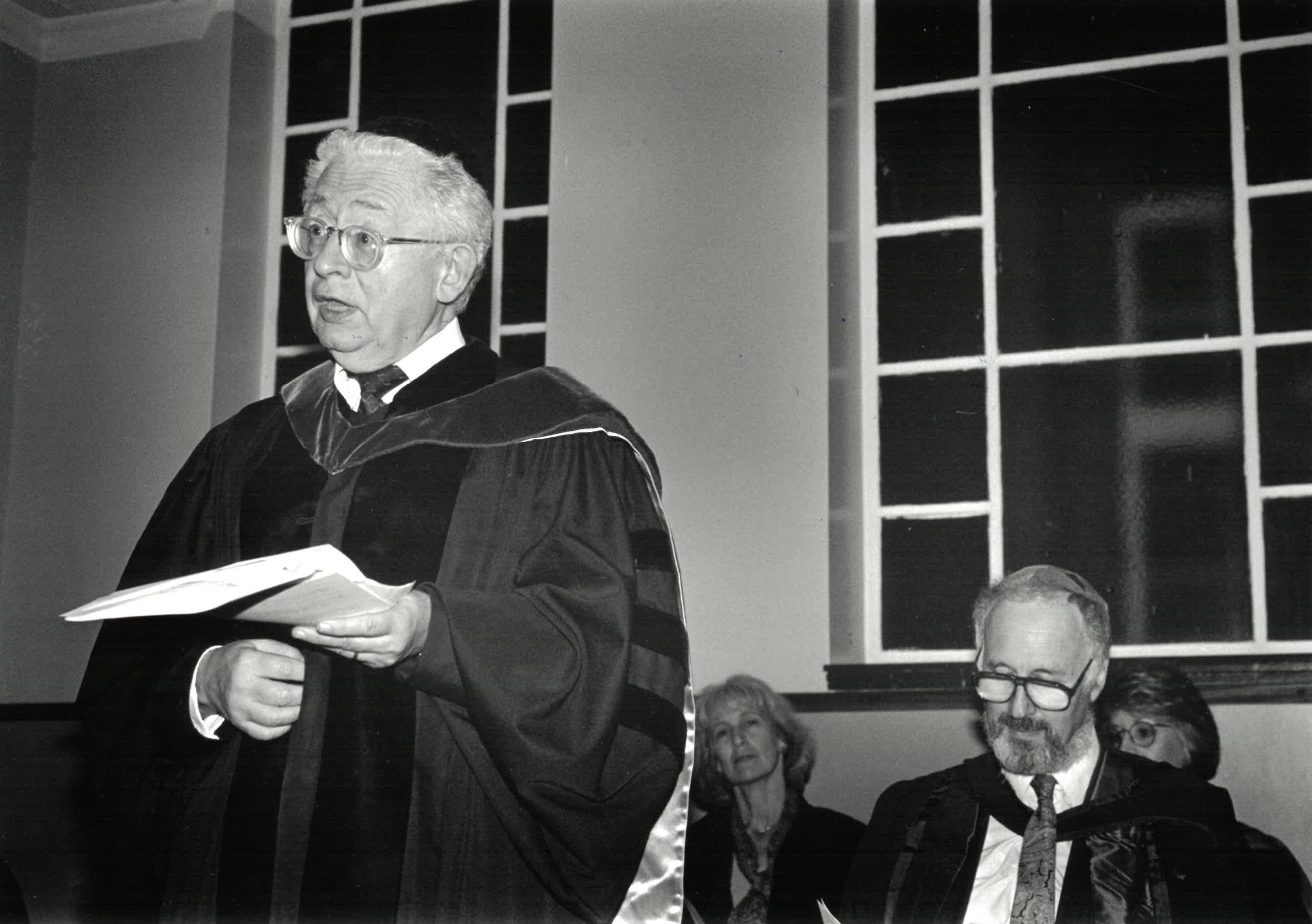
Ex libris Rabbi Albert H Friedländer Rabbi Albert Hoschander Friedländer OBE
Behind this ex libris of a simple drawing showing the Lion of Judah, a Jewish national and cultural symbol, lies the inspiring life-story of the liberal Rabbi Albert Hoschander Friedländer OBE (1927, Berlin – 2004, London). He was 11 years old when he witnessed the Nazi and mob violence and destruction aimed at Jews in the so called ‘Kristallnacht’ on 9th–10th November 1938 in Berlin. In 1939, his family fled Nazi Germany to the United States of America via Cuba. Friedländer attended university in Chicago and was ordained a rabbi at the Hebrew Union College in Cincinnati in 1952. After spending 14 years in the United States, he came to London in 1966, taking over the rabbinate at the Wembley Liberal Synagogue. In 1971, he moved to the Westminster synagogue and served as rabbi there until his retirement. He also continued to teach at the liberal Leo Baeck College in London.
It is only possible to scratch the surface here when engaging with Rabbi Friedländer’s wide ranging work and involvement in scholarly discourse, pastoral care, interfaith dialogue and last, but not least, with his dedication to his family. Early in his career, he wrote a biography on Leo Baeck and edited his writings, making them accessible for generations to come. Friedländer was also actively involved in the civil rights movement, taking his students to join Martin Luther King in his march in Memphis. In Britain, he participated in the Three Faiths Forum (now: Faith and Belief Forum), chaired by the British branch of the World Conference of Religions for Peace (1990-1994) and was president of the Conference of Christians and Jews. He was awarded an OBE for his contribution to inter-religious understanding in 2001. The German Government awarded both him and his wife Evelyn with the Grosses Bundesverdienstkreuz (First Class Order of Merit) for their impact on Anglo-German relations.
The 12 books from Rabbi Friedländer’s library that we were able to identify through his ex libris include a wide range of titles, among them works by Leo Baeck, such as his Romantische Religion (1922) or Immanuel Heinrich Ritter’s reflections about Mendelssohn and Lessing to commemorate the 100th anniversary of Mendelssohn’s death (Mendelssohn und Lessing : Nebst einer Gedächtnisrede auf Moses Mendelssohn zu dessen hundertjährigem Todestage gehalten im akademischen Verein für jüdische Geschichte und Literatur, 1886).
Several narrative strands unite the biographies behind the three visually rather diverse ex libris described above. Quite obviously, they tell us of men and women who loved books. And they also show that books were deemed of such importance that they were squeezed into the limited luggage space of refugees who were fleeing Nazi persecution. Finally, all three biographies feature people who showed keen interest in German-Jewish history and culture, as well as on other religious groups and cultures. They were open to and interested in interfaith dialogue – a fact reflected in the books they read and wrote, but also in the lives they lived.
There are certainly many more personal stories waiting to be explored behind the ex libris in our collection, and the items and biographies briefly outlined here deserve a deeper analysis than can be provided in this post. We hope that we have been able to give you some stimulating insights into the art of ex libris and the ways in which these intricate works of art can be used as a lynchpin for historical enquiry into collections of books.
Please have a stroll and contact us in case you have any information about the people behind the gallery of art that is tucked away beneath the covers of our books:
Ex Libris Herman Berlack
Ex Libris Adolf Heilborn
Ex Libris Lily and Theo Schwarz
Ex Libris Rabbi Martin Rozenberg
Ex Libris Sir Frederick Richmond
Ex Libris Walther Oyka
Ex Libris Emil Mayer
Ex Libris Lewandowsky
Ex Libris Kurt and Rose Battsek
Ex Libris AW
Ex Libris Wilhelm Brauer
Ex Libris Willy Cohn
Ex Libris Harold Aufochs
Ex Libris Rudolf Bleistein
Ex Libris Lazarus Goldschmidt
Works consulted
Nick Block, Ex Libris and Exchange: Immigrant Interventions in the German-Jewish Renaissance, in: The German Quarterly, Vol. 86, No. 3 (Summer 2013), pp 334-353.
Frederikshavn Art Museum and Exlibris Collection, The Digital Exlibris Museum, http://art-exlibris.net/search?query=kategori-73&pt=owner
Ariel J. Friedlander, Michal Friedlander Ben-Hur, Noam Friedlander, LionelBlue, Eveline Goodman-Thau, Paul Oestreicher, Rabbi Thomas Salamon, Rabbi JonathanWittenberg, Rabbi Tony Bayfield, Sidney Brichto, Michael Shire and Jane Clements, ALBERT FRIEDLANDER [Collection of Obituaries] in: European Judaism: A Journal for the New Europe, Vol. 37, No. 2 (Autumn 2004), pp. 103-122. https://www.jstor.org/stable/41443730, Last accessed: 31/10/23
Philip Goodman, Illustrated Essays on Jewish Bookplates (New York: Ktav Publishing House, 1971).
Hebrew Union College Cincinnati: Bookplate Inventory, https://huc.edu/libraries/special-collections/inventories-of-selected-collections/, last accessed 05/11/23.
Holocaust Memorial Day Trust, Albert Friedländer, https://www.hmd.org.uk/resource/albert-friedlander/, last accessed 05/11/23.
Martin Hopkinson, EX LIBRIS. The Art of Bookplates (London: British Museum Press, 2012).
H. Wetzler, Kurt Battsek [Obituary], in: AJR Information, Vol 33 No. 12 (December 1978).
Barbara Warnock, Gerty Simon’s subjects in London, (London: Wiener Library, 2019). https://wienerholocaustlibrary.org/2021/08/02/gerty-simons-subjects-in-london/, last accessed 05/11/23.
The ex libris shown in this Snapshot were found inside the following works:
Ex libris Harold Aufochs (in: a01280, Hermann Cohen, Jüdische Schriften. Ethische und religiöse Grundfragen, Bd. 1, 1928)
Ex libris Kurt and Rose Battsek (in: a01672, Felix A. Theilhaber, Schicksal und Leistung: Juden in der deutschen Forschung und Technik, 1931)
Ex libris Micha Battsek (in: LBI London Pamphlet Collection Box 74/1654, Emil Bernhard Cohn, Jüdischer Jugendkalender, 1934)
Ex libris Hermann Berlak (in: a01694, Neue jüdische Monatshefte, Das deutsche Judentum : Seine Parteien und Organisationen - Eine Sammelschrift, 1919)
Ex libris Wilhelm Brauer (in: a01881, Hermann Brinckmeyer, Die Rathenaus, 1922)
Ex libris Willy Cohn (in: a03804, J. Singer, Briefe berühmter christlicher Zeitgenossen über die Judenfrage, 1885)
Ex libris Rabbi Albert H Friedländer (in: A02675 Immanuel Heinrich Ritter, Mendelssohn und Lessing, 1886)
Ex Libris Adolf Heilborn (in: a02938, Maurice Barres, Vom Blute von der Wollust und vom Tode, 1907)
Ex libris Lazarus Goldschmidt (in: a02614, Dr. Strousberg und sein Wirken: von ihm selbst geschildert, 1876)
Ex libris Lewandowsky (in: a00179a, Adolf Harnack, Reden und Aufsätze, erster Band (A), 1904)
Ex libris Emil Mayer (in: a02060, Heinrich York-Steiner, Die Kunst als Jude zu Leben : (Minderheit verpflichtet), 1928)
Ex libris Walther Oyka (in: a03235, Samuel Steinherz,Jahrbuch der Gesellschaft fuer Geschichte der Juden in der Cechoslovakischen Republik : Achter Jahrgang, 1936)
Ex libris Sir Frederick Richmond Bt (in: a00578a, I. Epstein (ed), The Babylonian Talmud : Seder Nezikin I. Baba Kamma, 1935)
Ex libris Lilly and Theo Schwarz (in: a03177, Schalom Asch, Warschau – Roman, 1930)
Ex libris Sally Spiro, from The Michael Spiro Collection (in: Leo Melitz, Die Theaterstücke der Weltliteratur ihrem Inhalte nach wiedergegeben, 1904) – not catalogued yet
Ex Libris Initials AW (in: a00358, M. Pokrowsky, Geschichte Russlands von seiner Entstehung bis zur neuesten Zeit, 1929)
Images courtesy of
Photograph of Rabbi Albert Friedländer, by: Edi Kosmin/Leo Baeck College
Photograph of Lazarus Goldschmidt, National Library of Israel
Photograph of Lazarus Goldschmidt’s tombstone, by Igor Itkin
Ex libris Kurt and Rose Battsek (in: a02634a, Heinrich Graetz, Volkstümliche Geschichte der Juden. Volume 1, 1922)
Ex libris Micha Battsek (in: LBI London Pamphlet Collection Box 74/1654, Emil Bernhard Cohn, Jüdischer Jugendkalender, 1934)
Goldschmidt photo, The Pritzker Family National Photography Collection, Abraham Schwadron collection, The National Library of Israel
Acknowledgements
With many thanks to Cassy Sachar (Leo Baeck College), Igor Itkin (talmud.de), the National Library of Israel, Dr Barbara Warnock (Wiener Holocaust Library) and Penny Goldsmith for providing us with information and images for this snapshot.
Gathering the data about our library would not have been possible without the support of Malaika Muwanya and Clara Koser who reviewed our books for provenance markers on the LBI London research project Networks of Knowledge II – Going under Covers, led by our deputy director, Kinga Bloch.
Click here for an overview of all Snapshots of German-Jewish History and Culture.


